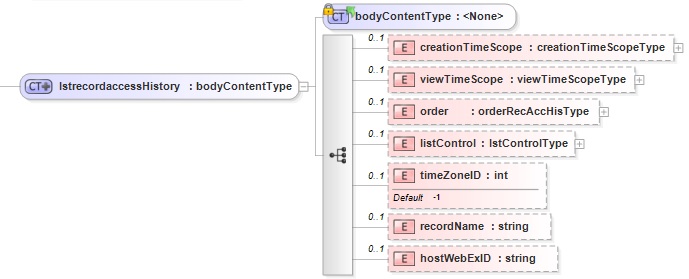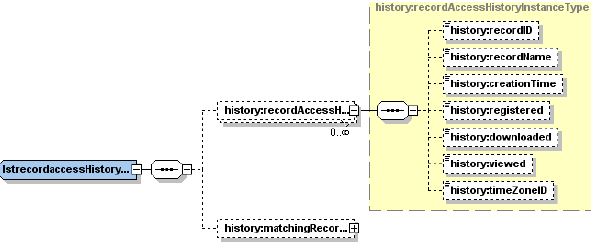LstrecordaccessHistory
Provides the access details for a previously recorded training session.
Note Regular hosts can only retrieve the access information of their
own recorded sessions, but site administrators can retrieve the access
information of all the recorded sessions on their sites
Request
The following schema diagram shows the structure of the elements in thelstrecordaccessHistory request message.
Figure 9-11 • Schema diagram for lstrecordaccessHistory

The sample XML document queries for the access history for
sessions that were recorded between June 28, 2018 and September 24, 2018.
<?xml version="1.0" encoding="UTF-8"?>
<serv:message xmlns:xsi="http://www.w3.org/2001/XMLSchema-instance">
<header>
<securityContext>
<webExID>hostid</webExID>
<password>hostpassword</password>
<siteID>0000</siteID>
<partnerID>9999</partnerID>
<email>johnsmith@xyz.com</email>
</securityContext>
</header>
<body>
<bodyContent xsi:type="java:com.webex.service.binding.history.LstrecordaccessHistory">
<viewTimeScope>
<viewTimeStart>6/28/2018 00:00:00</viewTimeStart>
<viewTimeEnd>9/24/2018 23:59:59</viewTimeEnd>
</viewTimeScope>
<listControl>
<startFrom>1</startFrom>
<maximumNum>100</maximumNum>
</listControl>
<order>
<orderBy>RECORDID</orderBy>
<orderAD>ASC</orderAD>
</order>
</bodyContent>
</body>
</serv:message>
For descriptions of the global elements in the security context of the
header, please see Global Request Elements in Security Context.
For descriptions of the non-global elements, please refer to “Elements
in WebEx XML Schema Definitions for the History Service”.
Response
The following schema diagram shows the structure of the elements in thelstrecordaccessHistoryResponse message.
Figure 9-12 • Schema diagram for lstrecordaccessHistoryResponse
The sample XML document shows an example of a possible response to the
preceding request document.
<?xml version="1.0" encoding="UTF-8"?>
<serv:message xmlns:serv="http://www.webex.com/schemas/2002/06/service"
xmlns:com="http://www.webex.com/schemas/2002/06/common"
xmlns:history="http://www.webex.com/schemas/2002/06/service/history">
<serv:header>
<serv:response>
<serv:result>SUCCESS</serv:result>
<serv:gsbStatus>PRIMARY</serv:gsbStatus>
</serv:response>
</serv:header>
<serv:body>
<serv:bodyContent xsi:type="history:lstrecordaccessHistoryResponse"
xmlns:xsi="http://www.w3.org/2001/XMLSchema-instance">
<history:recordAccessHistory>
<history:recordID>4134727</history:recordID>
<history:recordName>TC recording</history:recordName>
<history:creationTime>11/28/2008 05:51:24
</history:creationTime>
<history:registered>0</history:registered>
<history:downloaded>0</history:downloaded>
<history:viewed>3</history:viewed>
<history:timeZoneID>20</history:timeZoneID>
</history:recordAccessHistory>
<history:recordAccessHistory>
<history:recordID>4137042</history:recordID>
<history:recordName>TC siteadmin recording</history:recordName>
<history:creationTime>12/09/2008 03:07:33</history:creationTime>
<history:registered>0</history:registered>
<history:downloaded>0</history:downloaded>
<history:viewed>1</history:viewed>
<history:timeZoneID>20</history:timeZoneID>
</history:recordAccessHistory>
<history:recordAccessHistory>
<history:recordID>4137052</history:recordID>
<history:recordName>TC recording2</history:recordName>
<history:creationTime>12/09/2008 03:16:29</history:creationTime>
<history:registered>0</history:registered>
<history:downloaded>0</history:downloaded>
<history:viewed>1</history:viewed>
<history:timeZoneID>20</history:timeZoneID>
</history:recordAccessHistory>
<history:matchingRecords>
<serv:total>3</serv:total>
<serv:returned>3</serv:returned>
<serv:startFrom>1</serv:startFrom>
</history:matchingRecords>
</serv:bodyContent>
</serv:body>
</serv:message>
The result and exceptionID global elements allow you to confirm that
an instantiation request was successful. They are described in "Global Response
Elements Showing Results and Errors”.
